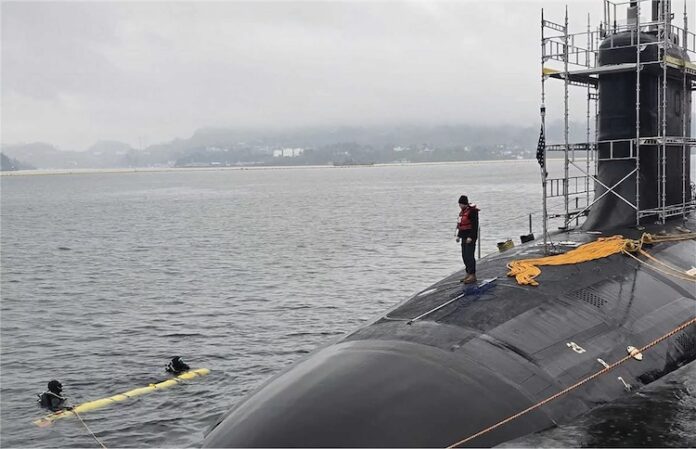
According to information published on the Facebook account of the U.S. Commander of Submarine Forces on May 30, 2025, the Virginia-class fast-attack submarine USS Delaware (SSN 791) successfully conducted a landmark unmanned mission in the U.S. European Command (EUCOM) area of responsibility. From Army Recognition.
The operation featured the Yellow Moray Unmanned Underwater Vehicle (UUV), a customized version of the REMUS 600 designed to perform a wide range of underwater tasks, including mine countermeasures, surveillance, reconnaissance, and hydrographic surveys. This mission marked the first-ever forward deployed launch and recovery of a UUV via a submarine’s torpedo tube to complete a tactical objective, establishing a major breakthrough in submarine-launched autonomous capabilities.
The mission involved three autonomous sorties of 6 to 10 hours each, conducted using the same Yellow Moray UUV (Unmanned Underwater Vehicle). All launches and recoveries were performed via U.S. Navy submarine Delaware’s torpedo tubes while submerged, without the use of divers. This operation validated the system’s reliability and effectiveness in real-world conditions, underscoring the strategic potential of integrating robotic platforms into traditional submarine operations. The ability to perform these missions autonomously enables new approaches to subsea and seabed warfare (SSW) while significantly reducing the risk to personnel.
The U.S. Navy USS Delaware (SSN 791), commissioned in April 2020, is the 18th submarine in the Virginia-class and part of the Block III series. It measures 115 m (377 ft) in length, has a beam of 10.3 m (34 ft), and a submerged displacement of approximately 7,800 tonnes. Propelled by an S9G nuclear reactor coupled to a pump-jet propulsor, it achieves submerged speeds exceeding 46 km/h (25+ knots) and can operate at depths beyond 240 m (800+ ft). The submarine is armed with 12 vertical launch system (VLS) tubes for Tomahawk cruise missiles and four 533 mm torpedo tubes for Mk 48 ADCAP torpedoes. Its sensor suite includes the AN/BQQ-10 sonar and Large Aperture Bow (LAB) array, providing superior undersea detection capabilities. It is also optimized for special operations, with reconfigurable payload spaces and dry deck shelter compatibility.
The Yellow Moray is a mission-configured variant of the REMUS 600 UUV, developed by HII’s Hydroid division. It is engineered for long-range, high-endurance operations at depths of up to 600 m (1,968 ft). The vehicle measures 3.25 m (10.7 ft) in length, has a diameter of 0.32 m (12.6 in), and weighs approximately 240 kg (530 lbs). Its modular design supports a variety of mission payloads including synthetic aperture sonar, side-scan sonar, CTD sensors, Doppler velocity logs (DVL), and inertial navigation systems. The system can operate autonomously in GPS-denied environments and execute complex routes in both shallow and deep waters.
The primary missions of the Yellow Moray UUV include seabed mapping, mine countermeasures, hydrographic reconnaissance, and undersea infrastructure monitoring. It is also capable of supporting intelligence, surveillance, and reconnaissance (ISR) operations in denied areas where traditional platforms may face high risk. The vehicle provides operational commanders with valuable environmental and tactical data, enabling informed decision-making and more effective battlespace preparation.
For the U.S. Submarine Force, the operational deployment of UUVs like the Yellow Moray represents a strategic enhancement to mission capabilities. These systems allow submarines to extend their reach beyond manned limits, conducting detailed surveys and reconnaissance in contested or hazardous environments without exposing the platform or its crew to danger. They also increase the tempo and persistence of undersea operations, as UUVs can be rapidly redeployed for repeated missions without requiring maintenance between sorties. Additionally, launching and recovering a UUV via torpedo tube eliminates the need for surfacing or diver support, preserving stealth and operational security.
Vice Admiral Rob Gaucher, Commander of Submarine Forces, emphasized that integrating autonomous systems aboard submarines reduces risk to personnel and enables distributed sensing in complex environments. He highlighted the Navy’s intent to expand the use of such capabilities fleet-wide, ensuring that future attack submarines are equipped not only with powerful weapons and sensors, but also with unmanned systems that multiply their effectiveness across the battlespace.
The mission also showcased the agility and innovation of Submarine Force and UUV Group 1 personnel. After an initial failure to recover the UUV during trials in a Norwegian fjord in February, due to damage discovered post-launch, the system was returned to the U.S. for urgent repair. SUBFOR then redeployed the UUV back to theater, and USS Delaware performed a successful expeditionary reload, executing multiple autonomous missions, including the first-ever pierside diver-assisted torpedo tube UUV load in Norway.
The success of this operation confirms the operational readiness of submarine-launched UUVs for a wide array of missions critical to undersea warfare. As the U.S. Navy advances toward greater autonomy in its undersea forces, the Yellow Moray’s deployment from USS Delaware establishes a crucial milestone in the evolution of 21st-century naval combat, enabling a future where manned and unmanned assets operate seamlessly to ensure undersea dominance.



